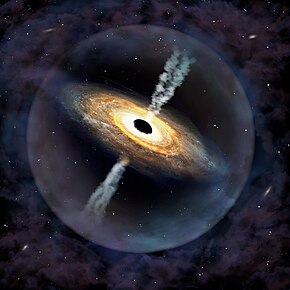Pōniuāʻena (/ˌpoʊniuːɑːˈɛnə/), also named J100758.264+211529.207 or J1007+2115, is the third most-distant quasar known, with a measured redshift of z = 7.515 or a lookback time of 13.02 billion years.[2] Its 1.5 billion–solar mass black hole is the most distant known black hole with a mass of over one billion solar masses, and models indicate that it must have formed not later than 100 million years after the Big Bang, before reionization.[3] Its discovery was announced in June 2020.[4] Only the quasars ULAS J1342+0928 (z = 7.54) and J0313–1806 (z = 7.64) are known to be more distant.[3][5]
| Pōniuāʻena J1007+2115 | |
|---|---|
 A depiction of Pōniuāʻena created by NOIRLab | |
| Observation data (Epoch J2000.0) | |
| Constellation | Leo |
| Right ascension | 10h 07m 58.264s |
| Declination | +21° 15′ 29.207″ |
| Redshift | 7.52[1] |
| Distance | 1.302×1010 light-years (3.99×109 parsecs) (light-travel distance) |
| Other designations | |
| J100758.264+211529.207, WISEA J100758.33+211529.4 | |
| See also: Quasar, List of quasars | |
The quasar was primarily observed at the Mauna Kea Observatories on the island of Hawaiʻi; it was first discovered at the Gemini Observatory and was further identified using data from the W. M. Keck Observatory, UKIRT, Magellan Telescopes, and ALMA.[6] Hawaiian language experts at ʻImiloa Astronomy Center gave it the name Pōniuāʻena [ˌpoːnijuwaːˈʔɛnə], which "evokes the unseen spinning source of creation, surrounded by brilliance."[7]
References
edit- ^ Yang et al. 2020
- ^ Monster Black Hole Found in the Early Universe, National Optical-Infrared Astronomy Research Laboratory, June 25, 2020
- ^ a b Brooks Hays (June 25, 2020). "Astronomers find massive black hole in the early universe". UPI.
- ^ Monster black hole found in the early universe, Keck Observatory, June 25, 2020 – via Science Daily,
The second-most distant quasar ever discovered now has a Hawaiian name
- ^ Temming, Maria (January 18, 2021), "The most ancient supermassive black hole is bafflingly big", Science News, vol. 199, no. 3, Washington, D.C.: Society for Science & the Public, p. 4, retrieved February 28, 2021
- ^ Yang, Jinyi; Wang, Feige; Fan, Xiaohui; Hennawi, Joseph F.; Davies, Frederick B.; Yue, Minghao; Banados, Eduardo; Wu, Xue-Bing; Venemans, Bram; Barth, Aaron J.; Bian, Fuyan; Boutsia, Konstantina; Decarli, Roberto; Farina, Emanuele Paolo; Green, Richard; Jiang, Linhua; Li, Jiang-Tao; Mazzucchelli, Chiara; Walter, Fabian (July 1, 2020), "Pōniuā'ena: A Luminous z=7.5 Quasar Hosting a 1.5 Billion Solar Mass Black Hole", The Astrophysical Journal, 897 (1), The Astrophysical Journal Letters: L14, arXiv:2006.13452, Bibcode:2020ApJ...897L..14Y, doi:10.3847/2041-8213/ab9c26, S2CID 220042206
- ^ Astronomers and immersion kumu announce newly-named discovery: Pōniuāʻena, ʻImiloa Astronomy Center, June 25, 2020
Further reading
edit- Yang, Jinyi; Wang, Feige; Fan, Xiaohui; Hennawi, Joseph F.; Davies, Frederick B.; Yue, Minghao; et al. (2020). "Pōniuā'ena: A Luminous z = 7.5 Quasar Hosting a 1.5 Billion Solar Mass Black Hole". The Astrophysical Journal. 897 (1): L14. arXiv:2006.13452. Bibcode:2020ApJ...897L..14Y. doi:10.3847/2041-8213/ab9c26. S2CID 220042206.